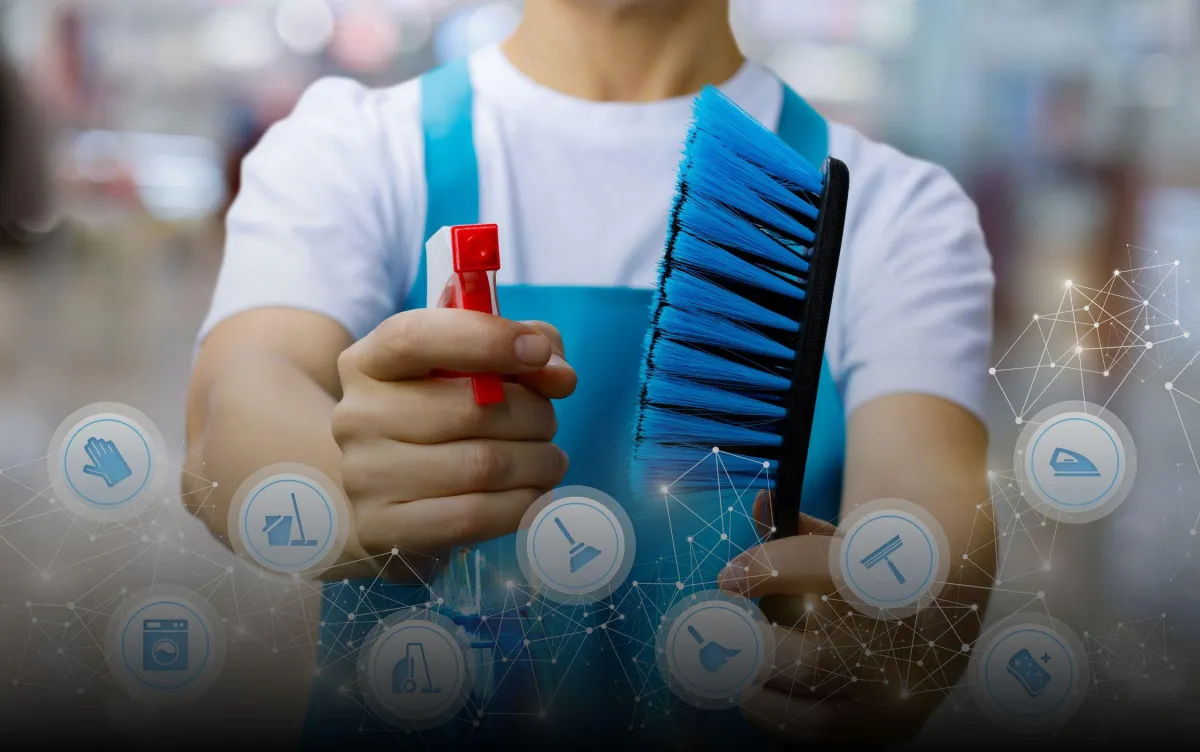
Deep Cleaning vs. Regular Cleaning: What Your Business Needs
Maintaining a clean and healthy workplace is essential for the productivity, safety, and well-being of employees and customers.
While regular cleaning is a standard part of everyday maintenance, deep cleaning is often necessary to achieve a higher level of cleanliness.
Understanding the differences between deep cleaning and regular cleaning is crucial for businesses that want to optimize their cleaning efforts and create a safe environment.
This blog will explore the benefits and purposes of both deep cleaning and regular cleaning, and help you determine which is right for your business.
What is Regular Cleaning?
Regular cleaning involves routine tasks that are performed daily, weekly, or monthly to keep a space tidy and prevent the buildup of dirt, dust, and germs.
These tasks are generally surface-level and focus on maintaining an acceptable standard of cleanliness in high-traffic areas.
Common Regular Cleaning Tasks
Regular cleaning typically includes:
Dusting surfaces such as desks, shelves, and light fixtures
Vacuuming carpets and mopping hard floors
Cleaning restrooms, including toilets, sinks, and mirrors
Emptying trash bins and replacing liners
Wiping down common touchpoints like doorknobs, light switches, and elevator buttons
Cleaning kitchen areas, including wiping down countertops and cleaning appliances
Regular cleaning is essential for maintaining day-to-day cleanliness and preventing dirt, dust, and germs from accumulating.
However, it does not address deeply embedded grime or areas that are not frequently cleaned.
Benefits of Regular Cleaning
Maintains a Consistent Level of Cleanliness:
Regular cleaning helps keep the office or facility looking presentable, ensuring a tidy and professional appearance for employees and visitors.Reduces the Spread of Germs:
By cleaning high-touch areas and surfaces regularly, businesses can help reduce the spread of germs, contributing to a healthier workplace.Promotes Employee Productivity:
A clean and organized workspace minimizes distractions and boosts employee morale, leading to increased productivity.Prevents Buildup of Dirt and Dust:
Routine cleaning prevents dirt, dust, and debris from accumulating to the point where they become more difficult to remove.
What is Deep Cleaning?
Deep cleaning goes beyond the surface level and involves thorough and detailed cleaning of hard-to-reach or neglected areas.
It addresses built-up grime, dirt, and bacteria that regular cleaning may not effectively remove.
Deep cleaning often includes more intensive procedures and specialized equipment to achieve a higher level of hygiene.
Common Deep Cleaning Tasks
Deep cleaning tasks may involve:
Cleaning and disinfecting carpets and upholstery to remove dirt, stains, and allergens
Cleaning air ducts and vents to improve indoor air quality
Scrubbing tile grout and cleaning hard-to-reach surfaces
Washing windows and cleaning blinds
Cleaning behind and underneath furniture, appliances, and equipment
Polishing floors and cleaning hard-to-access ceiling fixtures
Using specialized cleaning equipment for tasks like steam cleaning or pressure washing
Deep cleaning is typically performed less frequently than regular cleaning, but it plays a vital role in maintaining a truly clean and healthy environment.
Benefits of Deep Cleaning
Eliminates Deep-Seated Dirt and Grime:
Deep cleaning targets areas that regular cleaning cannot reach, removing dirt, bacteria, and other contaminants that have accumulated over time.Improves Indoor Air Quality:
By cleaning air ducts, carpets, and other surfaces that harbor allergens, deep cleaning can significantly improve the air quality in the workplace, benefiting employees' health.Reduces the Risk of Illness:
Thorough disinfection of high-touch areas and other hard-to-reach places helps minimize the spread of harmful bacteria and viruses.Restores the Appearance of Surfaces:
Deep cleaning can revitalize surfaces and materials that may have become dull or stained over time, such as carpets, tile, and furniture.Extends the Lifespan of Assets:
Regular deep cleaning helps maintain the condition of furniture, flooring, and equipment, which can reduce the need for costly replacements or repairs.
Comparing Deep Cleaning and Regular Cleaning
While both deep cleaning and regular cleaning are essential for maintaining a clean environment, they serve different purposes and are best used in combination.
Here's a closer look at the key differences between the two:
1. Frequency
Regular Cleaning: Performed daily, weekly, or monthly as part of an ongoing cleaning routine. The goal is to maintain a consistent level of cleanliness and hygiene in the workplace.
Deep Cleaning: Conducted less frequently, typically on a quarterly, semi-annual, or annual basis. It may also be done before or after special events, seasonal changes, or when transitioning between tenants.
2. Scope of Work
Regular Cleaning: Focuses on surface-level cleaning tasks, such as dusting, vacuuming, and wiping down common touchpoints. It aims to keep the space looking neat and presentable.
Deep Cleaning: Involves a more comprehensive approach, targeting areas that are often neglected during regular cleaning. It includes cleaning hard-to-reach spots, thorough disinfection, and specialized procedures like carpet cleaning or window washing.
3. Tools and Equipment Used
Regular Cleaning: Typically requires basic cleaning tools and supplies, such as microfiber cloths, vacuum cleaners, mops, and all-purpose cleaners.
Deep Cleaning: May involve the use of specialized equipment, such as steam cleaners, power washers, floor polishers, and HEPA vacuum cleaners. It may also require stronger disinfectants or cleaning agents.
4. Time and Effort Required
Regular Cleaning: Takes less time and effort because it involves routine tasks that are completed on a regular basis. It is usually carried out by in-house cleaning staff or a cleaning service.
Deep Cleaning: Is more time-consuming and labor-intensive due to the detailed nature of the tasks. It often requires professional cleaning services with specialized skills and equipment.
5. Level of Cleanliness Achieved
Regular Cleaning: Maintains a baseline level of cleanliness that is adequate for day-to-day operations but may not address deeply embedded dirt, grime, or bacteria.
Deep Cleaning: Achieves a much higher level of cleanliness, addressing areas that are overlooked during regular cleaning and ensuring a thoroughly sanitized and hygienic environment.
Determining What Your Business Needs
To determine whether your business needs regular cleaning, deep cleaning, or a combination of both, consider the following factors:
1. Type of Business and Industry
The type of business you operate can significantly impact your cleaning requirements. For example:
Healthcare facilities, laboratories, and food processing plants require more frequent deep cleaning due to strict hygiene standards and regulatory requirements.
Offices, retail stores, and educational institutions may benefit from routine regular cleaning with occasional deep cleaning to maintain high standards of cleanliness.
Industrial facilities and warehouses may need deep cleaning to address specific areas, such as heavy machinery, workspaces, and break rooms.
2. Size and Layout of the Facility
Larger facilities with complex layouts may have more areas that require deep cleaning, such as storage rooms, multiple restrooms, or large kitchens.
If your facility has hard-to-reach areas, high ceilings, or lots of carpeting, deep cleaning may be more essential to maintaining a clean environment.
3. Foot Traffic
High-traffic areas, such as lobbies, restrooms, and break rooms, tend to accumulate more dirt, dust, and bacteria.
Regular cleaning can help maintain cleanliness in these spaces, but deep cleaning is necessary to eliminate deep-seated grime and ensure a truly hygienic environment.
Businesses with heavy foot traffic should consider scheduling deep cleaning more frequently.
4. Presence of Allergens and Pollutants
If your workplace has a high concentration of dust, allergens, or airborne pollutants, deep cleaning can help improve air quality and reduce health risks for employees.
This is especially important for businesses where employees have allergies or respiratory conditions.
5. Seasonal Needs
Certain businesses may require deep cleaning during specific times of the year. For example:
Spring cleaning helps eliminate dust and allergens accumulated during the winter months.
Pre-holiday cleaning ensures that the workplace is prepared for holiday events or increased customer traffic.
Post-construction cleaning is essential after renovations or remodeling to remove construction dust and debris.
6. Budget Constraints
While deep cleaning can be more costly than regular cleaning, it is a worthwhile investment for maintaining a healthy and safe work environment.
To optimize your cleaning budget, you can establish a schedule that combines regular cleaning with periodic deep cleaning based on your facility's specific needs.
Creating a Balanced Cleaning Schedule
For most businesses, a combination of regular cleaning and occasional deep cleaning is the best approach to maintaining a clean and healthy environment.
Here are some tips for creating an effective cleaning schedule:
Assess Your Facility's Needs:
Determine which areas require daily, weekly, or monthly cleaning and which need periodic deep cleaning. Identify high-traffic zones, high-touch surfaces, and areas prone to dirt accumulation.Schedule Deep Cleaning During Off-Peak Hours:
To minimize disruptions, plan deep cleaning during weekends, holidays, or after-hours when the facility is less busy.Use Professional Cleaning Services When Needed:
For specialized deep cleaning tasks, such as carpet cleaning or window washing, consider hiring professional cleaning services with the right equipment and expertise.Train Employees on Daily Cleaning Practices:
Encourage employees to contribute to maintaining a clean workspace by following daily cleaning practices, such as wiping down their desks and cleaning up after themselves in common areas.Monitor and Adjust the Cleaning Schedule:
Regularly evaluate the effectiveness Incorporating both deep cleaning and regular cleaning into your business's cleaning routine is more than just a strategy for maintaining appearances; it’s a proactive approach to ensuring a healthier and safer work environment.
When businesses prioritize cleanliness, they create an atmosphere where employees feel valued and are more likely to perform at their best, and where customers or clients have a positive experience.
Additional Tips for Implementing Effective Cleaning Practices
To make the most out of your cleaning efforts and get the best results from both regular and deep cleaning, consider the following strategies:
1. Partner with a Professional Cleaning Service
If you lack the resources to carry out deep cleaning internally, consider partnering with a professional cleaning service that specializes in commercial cleaning.
Professional cleaning companies offer expertise in handling various types of cleaning tasks and can provide guidance on the appropriate cleaning schedule for your business.
They also have access to specialized cleaning equipment, such as high-powered vacuums, steam cleaners, and eco-friendly cleaning agents.
Choosing the right cleaning service involves considering their experience, the range of services they offer, and their reputation in the industry.
Businesses that want to prioritize sustainability can also look for cleaning services that offer green cleaning solutions.
2. Invest in High-Quality Cleaning Supplies and Equipment
Even if you use an external cleaning service for deep cleaning, equipping your staff with quality cleaning supplies for regular cleaning is crucial.
High-quality supplies, such as microfiber cloths, can make daily cleaning more effective by trapping dirt and dust rather than spreading it around.
Using eco-friendly cleaning products also supports a safer environment by reducing exposure to harsh chemicals.
Consider acquiring specialized equipment for certain tasks, such as HEPA-filtered vacuums to improve air quality, and floor cleaning machines for hard surfaces.
This investment can reduce the frequency of deep cleaning by keeping the environment consistently cleaner.
3. Incorporate a Preventive Maintenance Schedule
Deep cleaning is a critical part of preventive maintenance. Regular cleaning may prevent immediate issues, but scheduling preventive deep cleaning ensures that dirt, mold, and other contaminants do not build up over time, which could lead to costly repairs or health concerns.
For example, cleaning HVAC systems and air ducts can prevent dust and allergens from circulating throughout the building.
Maintaining cleanliness in restrooms can prevent mold growth and unpleasant odors, while regular floor maintenance can extend the life of carpets and hard floors.
4. Encourage Employee Participation in Daily Cleaning Efforts
While hiring professional cleaners is important, employees can play a role in keeping the workplace tidy.
Encouraging good habits like cleaning up after meetings, wiping down desks, and properly disposing of waste helps maintain a clean environment between professional cleaning sessions.
Provide the necessary supplies and establish guidelines for shared spaces like break rooms and restrooms.
Consider adding hygiene stations with hand sanitizers and disinfecting wipes in various areas to promote a culture of cleanliness.
5. Track Cleaning Progress and Review Your Plan Regularly
To ensure your cleaning strategy remains effective, track the progress of both regular and deep cleaning tasks.
Conduct periodic inspections of different areas in your facility to identify any cleanliness issues. If certain areas seem to accumulate dirt quickly, adjust your cleaning schedule accordingly.
Having a cleaning checklist can also help keep track of completed tasks and identify areas that require more frequent attention.
This approach ensures that no area is overlooked and that both regular and deep cleaning needs are met.
When Should You Prioritize Deep Cleaning?
While regular cleaning is important for everyday maintenance, there are specific scenarios where deep cleaning should take precedence:
Before or After a Major Event:
If your business is preparing for a major event, such as a company-wide meeting, conference, or customer event, deep cleaning can help make a positive impression.
Similarly, a thorough cleaning after the event ensures that the space is restored to its original condition.Post-Construction or Renovation:
If you’ve recently completed construction or renovation work, deep cleaning is essential to remove dust, debris, and any construction residues.
This ensures a safe and clean environment for employees and customers.After an Outbreak of Illness:
If there has been an outbreak of illness in the workplace (e.g., flu, COVID-19), deep cleaning can help eliminate germs and viruses from surfaces and air ducts, reducing the risk of further spread.Seasonal Changes:
Seasonal deep cleaning, such as spring cleaning, can help address accumulated dust and allergens from winter or prepare the facility for summer operations.
Additionally, changes in weather often bring unique cleaning challenges, such as wet or muddy floors in the winter.Occupancy Turnover:
For businesses that lease office space or manage tenant-occupied buildings, deep cleaning is crucial between occupancy changes.
This ensures a clean and sanitized space for new tenants and helps preserve the condition of the property.
The Role of Green Cleaning in Regular and Deep Cleaning
Businesses increasingly recognize the importance of sustainability and environmental responsibility.
Green cleaning practices can be incorporated into both regular and deep cleaning routines to reduce the environmental impact while maintaining high cleanliness standards.
Benefits of Green Cleaning
Improves Indoor Air Quality:
Eco-friendly cleaning products typically emit fewer volatile organic compounds (VOCs), which can improve air quality and reduce respiratory problems for employees.Reduces Exposure to Toxic Chemicals:
Green cleaning products contain fewer harsh chemicals, which reduces health risks for cleaning staff and building occupants.Supports Environmental Sustainability:
Using biodegradable and eco-friendly products helps minimize waste and pollution, aligning your business with sustainable practices.Enhances Employee Morale and Well-being:
Employees are increasingly aware of their work environment's impact on their health. A commitment to green cleaning shows that the company cares about their well-being and the environment.
Incorporating Green Cleaning Practices
Use Environmentally Friendly Cleaning Products:
Choose products certified by recognized environmental organizations, such as Green Seal or EcoLogo.Reduce Waste by Using Reusable Cleaning Tools:
Opt for microfiber cloths, reusable mop heads, and other sustainable cleaning supplies.Implement Recycling Programs:
Encourage waste separation and recycling within the facility to support sustainable practices.Train Cleaning Staff in Eco-Friendly Practices:
Provide training on green cleaning techniques, such as using the correct amount of cleaning solution and reducing water usage.
Conclusion
A comprehensive cleaning strategy that balances both regular and deep cleaning is essential for maintaining a healthy, safe, and appealing business environment.
While regular cleaning serves to keep daily dirt and clutter under control, deep cleaning ensures that every corner is thoroughly sanitized and free of deeply embedded grime.
By understanding the distinct roles of regular and deep cleaning, businesses can develop a cleaning schedule tailored to their specific needs.
Whether it involves seasonal deep cleaning, daily maintenance, or a focus on green cleaning practices, a commitment to cleanliness goes beyond aesthetics—it’s about protecting the health of employees, customers, and the community.
Investing in professional cleaning services, quality cleaning supplies, and a well-planned cleaning routine can help your business avoid costly problems in the long run.
Ultimately, maintaining a clean and healthy workplace is a continuous process that requires attention, planning, and a dedication to excellence.
Businesses that prioritize cleanliness can reap the rewards of a more productive workforce, a better reputation, and a healthier environment for all.



